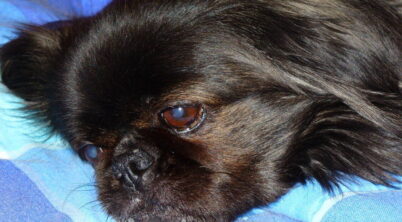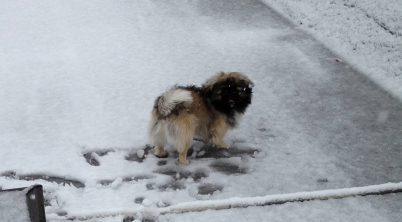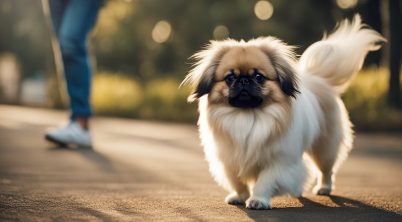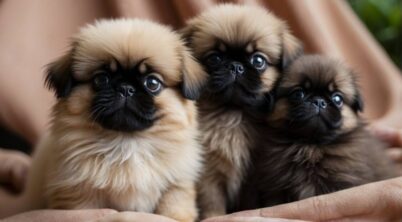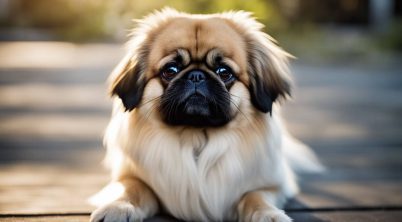Pekingese dogs, renowned for their distinct appearance with a flat face and lavish coat, exhibit unique eating habits that are characteristic of their breed. Their preferences and nutritional requirements are shaped by their size, energy levels, and breed-specific health considerations. While these canines maintain a regal demeanor, their eating patterns are decidedly down-to-earth, favoring regularity in their meal routines. Smaller portion sizes are typically more suitable for the Pekingese due to their compact build, and any changes in their usual eating habits can serve as early indicators of potential health issues.
Understanding the Pekingese’s dietary needs involves acknowledging the challenges that their physiology presents. Brachycephalic or short-faced breeds, including the Pekingese, tend to gulp air when eating, which can lead to gassiness. The composition of their diet plays a crucial role in this aspect, as heavily meat-based diets have been found to reduce flatulence in comparison to those that contain fibrous or difficult-to-digest ingredients. Moreover, the feeding routine for a Pekingese should be adjusted based on their individual requirements, taking into account factors such as age, size, and activity level to maintain optimal health.
It is also crucial to consider that Pekingese are prone to dental issues, which makes dental hygiene a vital component of their care. Regular dental maintenance not only supports their overall well-being but also ensures that they can continue to eat comfortably and enjoy their meals without pain or discomfort. Thus, owners must be vigilant and responsive to their Pekingese’s eating habits and health needs, creating a balance of proper diet and care that supports the breed’s well-being.
Table of Contents
Understanding the Pekingese Breed
The Pekingese is a distinct toy breed, characterized by its prominent history and regal stature. Originating from ancient China, these dogs are recognized for their lion-like appearance, with a lavish mane accentuating their shoulders and neck. Pekingese puppies and adult dogs share a notable brachycephalic facial structure, meaning they have a short nose and flat face.
In terms of temperament, the Pekingese displays an affectionate yet dignified behavior. They exhibit loyalty and closeness to their owners, making them cherished companions in many households. Their size and temperament suit family environments as well as the company of single adults or the elderly. This breed’s specific needs should be discussed with a dog breed consultant for optimal care.
Pekingese Dietary Needs:
- Small breed formula: Catering to their size and energy levels.
- Balanced diet: For general well-being and health maintenance.
Health Considerations:
- Brachycephalic concerns: Potential for respiratory challenges.
- Monitoring weight: Preventing obesity is important due to their size.
Despite their small stature, Pekingese require regular exercise and mental stimulation to maintain health and stave off boredom. Their brachycephalic nature necessitates consideration during vigorous activity, particularly in warmer climates, to prevent overheating.
Understanding and catering to these traits ensures the Pekingese thrives in its environment and maintains its noble and endearing disposition. When welcoming a Pekingese into a home, it is imperative that owners are informed and prepared to meet the unique requirements of this exquisite toy breed.
Establishing Healthy Eating Habits
Understanding and implementing healthy eating practices are critical for the Pekingese, from puppyhood through their senior years. Their dietary needs must take into account their size, breed-specific health issues, and life stage to promote well-being and prevent common ailments.
Assessing Diet Through Different Life Stages
Puppy: Puppies require a diet rich in nutrients to support rapid growth. Aim for high-quality puppy food that provides a balanced blend of proteins, carbohydrates, fats, vitamins, and minerals.
Adult Pekingese: Adults need a well-balanced diet to maintain a healthy weight and energy levels. Typically, 1/2 to 1 cup of kibble, split into two meals, is sufficient.
Senior: As they age, their metabolism slows down. Seniors benefit from diets lower in calories but rich in fiber to aid digestion, as well as added joint support supplements to combat arthritis.
Identifying Appropriate Food Types and Brands
- Kibble: Look for brands with high-quality animal proteins as the first ingredient.
- Wet Food: Can provide hydration and is often more appealing for picky eaters.
- Homemade Diets: Should be balanced and vet-approved to avoid nutrient deficiencies.
- Natural and Whole Food Options: May offer higher nutrient content when properly formulated.
Addressing Pekingese-Specific Health Issues with Diet
Breathing Problems: Avoid obesity, which can exacerbate breathing difficulties; diets should be low in sodium and fat.
Skin Conditions and Allergies: Seek out foods with omega fatty acids, limited ingredients, and novel proteins.
Dental Health: A combination of dry food and regular cleanings can help maintain dental health, reducing the risk of dental disease.
Preventing and Treating Common Health Problems
- Obesity: Monitor calorie intake and body condition, adjusting the diet to prevent excessive weight gain.
- Joint Problems: Provide diets enhanced with glucosamine and chondroitin.
- Digestive Issues: Ensure diets include probiotics and prebiotics to support gut health.
Schedules and Meal Planning Consistency
- Feeding Schedule: Two consistent meals per day can aid digestion and prevent stomach issues.
- Routine: Regular feeding times contribute to behavioral consistency and training.
Nutritional Supplements and Treats
- Vitamins and Minerals: Ensure the diet provides essential vitamins and minerals; supplements may be necessary on a vet’s advice.
- Healthy Treats: Should be used sparingly, fitting within the daily calorie allowance, and can include nutrient-dense options like small pieces of carrot or apple.
Implementing a Balanced Diet
In creating a well-rounded diet for a Pekingese, it’s essential to include the right mix of nutrients tailored to their breed-specific needs, while managing portion sizes to prevent health issues such as obesity.
Essential Nutrients for Pekingese
Pekingese, with their small stature, benefit significantly from a diet rich in high-quality animal protein such as beef, chicken, turkey, lamb, fish, and eggs. These proteins support their muscle development and upkeep. Healthy fats are crucial for their energy levels and to support a healthy coat, with sources including flaxseed oil or fish oil providing omega-3 fatty acids. Digestible carbohydrates can be supplied through cooked rice, potatoes, or oats; these should take up a smaller portion of the diet. Additionally, to ensure optimal health, a variety of vitamins and minerals should be incorporated, which can be found naturally in vegetables, legumes, fruits, and berries.
The Role of Proportions in Feeding
A Pekingese’s feeding regimen should follow portion control to maintain a healthy weight and prevent obesity, a common concern in smaller breeds. Each meal’s feeding amount needs to be measured, and the total daily calories should align with the dog’s age, weight, and activity level. This careful monitoring of portion sizes helps prevent overfeeding, which can lead to weight gain and related health issues.
Incorporating Whole Foods and Variety
Introducing a range of whole foods such as lean meats, healthy grains, vegetables, and fruits can ensure a diverse supply of essential nutrients while making meals more appealing. Rotating different foods and flavors can also prevent a Pekingese from becoming picky, keeping mealtime interesting. Including vegetables like carrots and green beans and fruits such as blueberries offers natural vitamins and minerals that support overall well-being.
Understanding the Risks of Improper Feeding
Failure to implement a balanced diet can lead to various health issues for a Pekingese, including bloat, obesity, malnutrition, and digestive issues. Bloat is a serious condition that can occur from eating too quickly or from having one large meal a day, so splitting meals into smaller, more frequent portions is advisable. Obesity not only impacts the Pekingese’s mobility but also increases the risk of other health complications. To avoid these risks, it’s imperative to maintain balanced nutrition and regular veterinary check-ups.
Dealing with Behavioral Eating Challenges
Effective management of your Pekingese’s eating behavior is a multi-faceted endeavor, requiring a focus on addressing pickiness, implementing proper training techniques, and recognizing and responding to stress-related feeding issues.
Overcoming Pekingese Picky Eating Behaviors
Though Pekingese dogs can be selective with their food, consistency and variety play key roles in overcoming picky eating behaviors. Offering a balanced diet that includes different flavors and textures may entice a Pekingese to eat more regularly. It is important to remove uneaten food after a reasonable amount of time to establish a routine, thus avoiding the development of stubbornness regarding meal times.
Training Techniques to Aid in Feeding
Incorporating feeding behavior into your Pekingese’s training regimen can be beneficial. Positive reinforcement—such as praising or offering a healthy treat when your dog eats well—can encourage proper feeding behavior. Involving a professional dog trainer might be necessary for persistent cases, as they can offer specialized guidance tailored to your dog’s unique temperament.
Responding to Stress-Induced Eating Issues
Stress and anxiety, including separation anxiety, can negatively impact a Pekingese’s desire to eat. Identifying signs of stress early and creating a supportive environment are crucial. Routine and stability help mitigate stress, as can dedicated time for play and exercise. For severe anxiety, consult a vet who may suggest behavior modification strategies or medical intervention.
Health Care and Nutrition Monitoring
Pekingese owners should prioritize health care and nutrition monitoring to ensure their pets maintain optimal wellbeing. This involves regular vet check-ups and diet adjustments, dental health management through diet, and recognizing the importance of food sensitivity testing.
Regular Health Check-ups and Dietary Adjustments
Regular health check-ups by a veterinarian should be a routine part of a Pekingese’s care. During these visits, discussions about the dog’s diet and any necessary dietary changes are essential. The vet can assess the Pekingese’s age, weight, and activity level to recommend appropriate food portions and nutrient profiles.
Maintaining Dental Health Through Diet
Dental health in Pekingese is crucial to overall health, and diet plays a significant role. Foods designed to reduce plaque and tartar buildup can help, as well as providing chew toys that promote gum health. Owners are advised to regularly brush their Pekingese’s teeth to prevent gum disease.
Understanding the Need for Food Sensitivity Testing
Pekingese can develop food allergies or sensitivities, manifesting in various symptoms such as skin irritations or gastrointestinal issues. An elimination diet, conducted under a veterinarian’s supervision, can help identify specific allergens. Once known, these sensitivities can be managed with a tailored diet to avoid triggering ingredients.
Practical Aspects of Feeding a Pekingese
Proper feeding of a Pekingese involves not only the food provided but also the environment and equipment used. These factors contribute significantly to their overall health and well-being.
Choosing the Right Feeding Equipment
When feeding a Pekingese, feeding bowls should be of the appropriate size and height to prevent unnecessary strain on their neck and back. Stainless steel bowls are recommended for their hygiene and ease of cleaning. Regular cleansing of the bowls is essential to prevent bacterial growth and protect the Pekingese’s health.
- Preferred Feeding Bowls: Stainless steel, ceramic
- Hygiene: Wash bowls daily with hot, soapy water
Creating an Optimal Feeding Environment
The feeding area should be a peaceful space, allowing the Pekingese to eat without stress. A quiet corner away from high traffic areas reduces anxiety and distractions. Ensure that the feeding area is well-maintained and clean, offering comfort and promoting hydration by having fresh water accessible at all times.
- Feeding Area Qualities: Quiet, low-traffic, clean
- Water Availability: Constant access to fresh water
Deciphering Food Labels and Marketing
Understanding food labels is crucial for the Pekingese’s diet. Look beyond marketing strategies and brand promises to the ingredient list. High-quality animal proteins should be listed first, ideally followed by natural sources of vitamins and minerals. Be wary of label claims that may be misleading, such as “premium” or “natural,” which may not be regulated terms.
- Important Label Components: Real meat listed first, clear ingredient list, minimal additives
- Marketing Claims to Scrutinize: Premium, gourmet, artisanal
By considering these practical feeding aspects, owners can greatly enhance their Pekingese’s nutritional experience.

